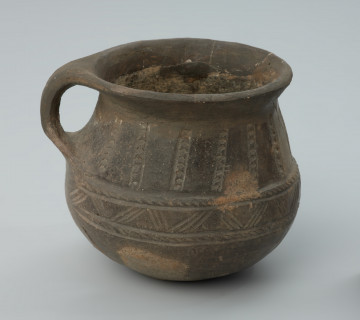
Mug with ear
National Museum in Szczecin
Part of the collection: Antiquity
The presented vessel with two handles is known as “situla”, which is means a bucket in Latin. The creators of this type of pottery vessels were inspired by the Roman bronze vessels imported to the northern parts of Europe. This situla is very carefully made – it has a smooth, dark brown and sometimes black surface, and on the edge of its bulge it has a decoration in the form of lines with overlapping two triple zigzags. Above the curve of the body, the situla is decorated with artistic ornamentation. This decoration is typical of the pottery of the 1st-2nd century Wielbark culture. This culture, associated with the Germanic tribes of Goths and Gepids, owes its name to the town of Wielbark near Malbork. The situla from the Zagórzyce cemetery is described in the archival documentation as a pottery urn used for cremated remains of the deceased. The first, amateur excavations carried out in the location where the situla was found were led in 1914 by a philosophy student, Paul Dräger. He discovered then the cremation burials furnished with, among others, one-edged swords, javelin arrowheads and fibulae – brooches sued to fasten the clothing. Further examination of the cemetery was conducted then in August 1915 by an archaeologist and a conservator-restorer from Szczecin, Adolf Stubenrauch, who discovered two more pit graves and a pit with debris that contained fragments of vessels, slag, and a destroyed bronze brooch. In 1935 more broader archaeological excavations were carried out by Hans Jürgen Eggers, an archaeologist from Szczecin museum, who discovered in this location 18 graves in total. Part of the monuments from Zagórzyce was stored in the regional museums in Łobez and Resko.
Bartłomiej Rogalski
Author / creator
Dimensions
cały obiekt: height: 23.8 cm
Object type
furnishings and equipment; container; vessel (container); funerary vessel
Technique
manual modelling
Material
clay
Creation / finding place
Owner
Muzeum Narodowe w Szczecinie
Identification number
Location / status